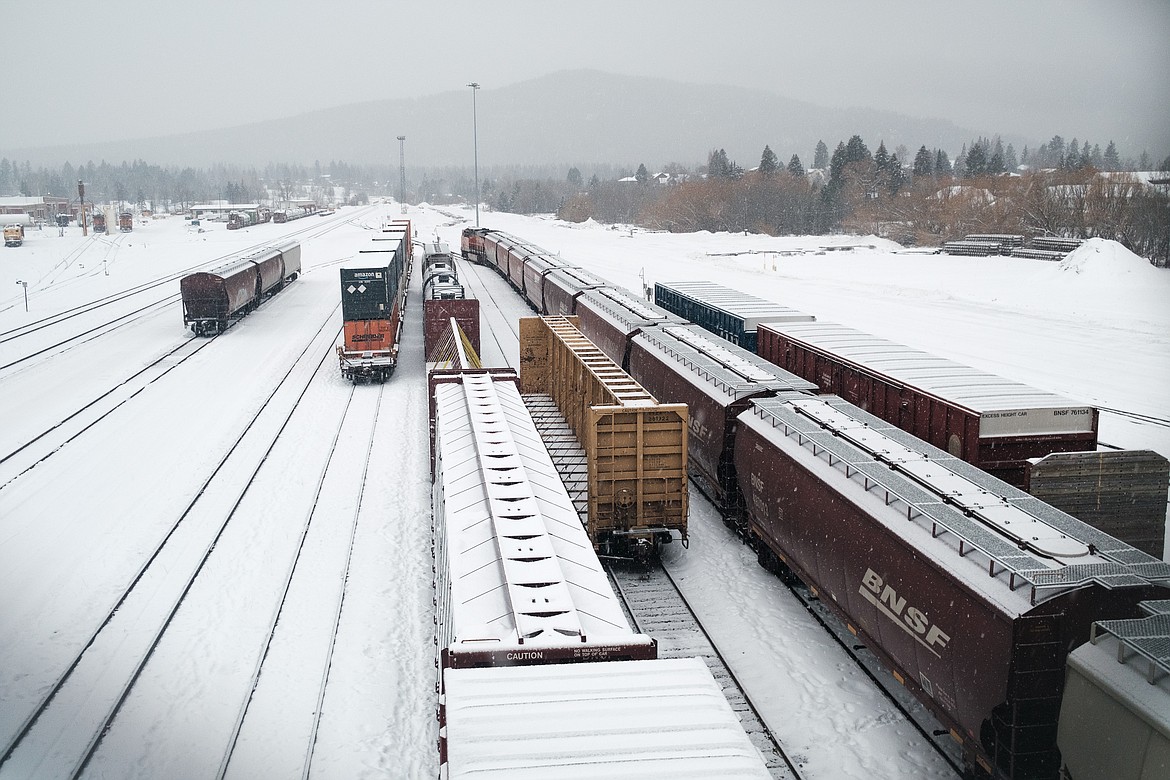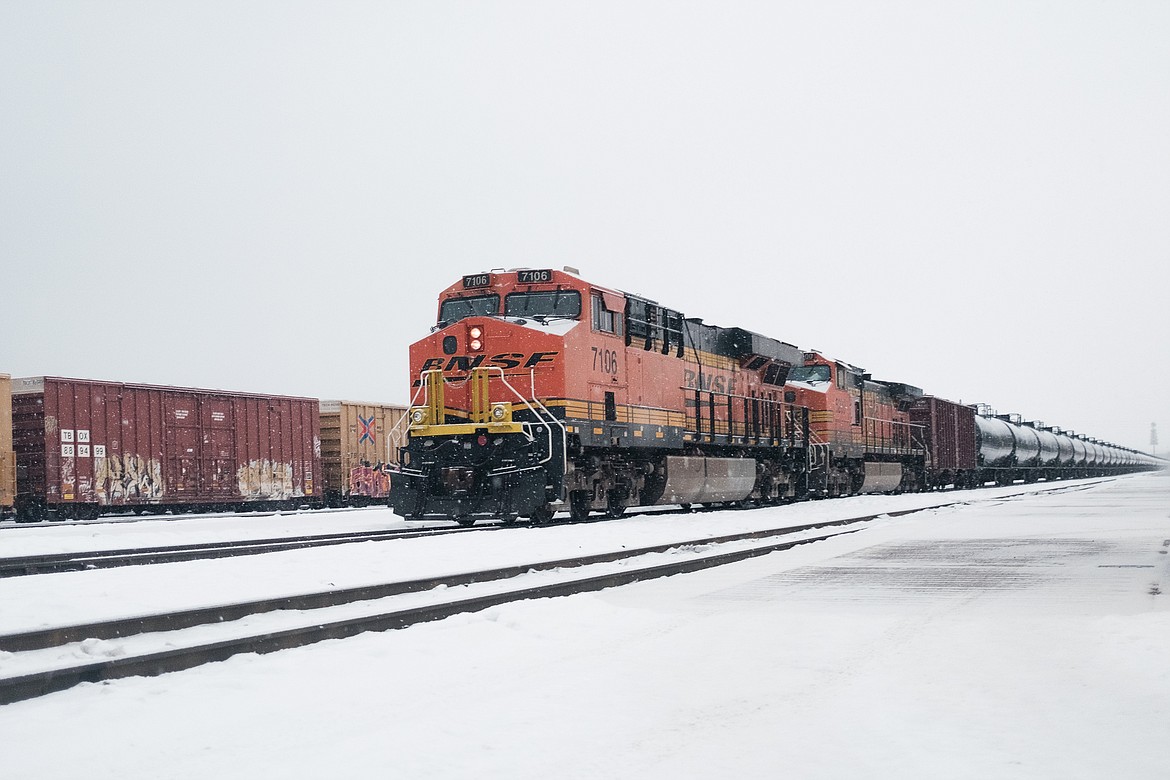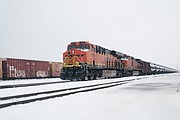New contract doesn't fix working conditions, say rail workers
A monthslong labor dispute between the Class I railroads and rail worker unions ended Dec. 2 with Congress’ intervention, subjecting workers to a new contract and using the 1926 Railway Labor Act to prevent a potential strike.
Local rail labor leaders, though, are disappointed with the lack of sick day provisions in their new contract and are voicing concerns that their grievances with precision scheduled railroading and BNSF Railway’s Hi-Viz attendance policy went unaddressed in negotiations.
Angered BNSF workers based out of Whitefish Depot believe that Congress undercut their collective bargaining power by forcing through the new deal.
The contract was hammered out by an emergency arbitration board put together by President Joe Biden, who hoped to avert a strike that businesses feared would shut down critical freight supply lines across the country.
The contract included wage hikes — including retroactive pay — and bonuses for service time, but many workers felt it didn’t go far enough. It also set aside three days for workers to seek preventative medical care, but the appointments must be scheduled well in advance and will only be granted on Tuesdays, Wednesdays, or Thursdays.
When the contract initially went to a vote before members of the 12 unions that represent the nation’s rail workers, four rejected it. One of the dissenting unions was SMART TD, which represents many BNSF employees based in Whitefish.
The deal would have required unanimous passage among the unions to be ratified had Congress not intervened.
“I don't know anybody that voted for it,” said yardman and local SMART TD representative Josh Ramey. “And if they did, they wouldn't talk about it.”
Workers interviewed said that they felt the railroads didn’t negotiate in good faith, because they were banking on the federal government stepping in.
“It took away our ability to strike, and hamstrung the unions,” said Ramey.
He pointed to what he sees as different standards for other freight workers who also play critical roles in the supply chain.
“I don’t understand how longshoremen can strike but we can’t,” Ramey said.
AMONG THE union members’ sticking points during negotiations were the freight carrier’s unwillingness to budge on granting paid sick days and to modify their railroad operations and attendance policies.
Although the sick day demands were among the most well publicized, interviews with workers reveal multiple grievances tied to BNSF’s Hi-Viz point-based attendance policy and the railroad’s decision to run longer trains with fewer crew.
Workers say that they are afraid to call out sick or with fatigue, because of the consequences under the Hi-Viz regime.
“To be quite frank, it would be nice to get paid sick days but we just want time off,” said JB Johnson, BNSF conductor and local union leader,
Under Hi-Viz, workers are docked points for not answering phone calls from the scheduling office. The deductions are more severe on “high impact” days, which include Fridays, weekends and holidays.
If a worker’s points dip too low, they face disciplinary action.
Under the policy, each worker starts with 30 points, but the process of earning points back is slow. The point total never resets.
Under previous policies, train crew were required to be available to work for 75% of the time, but that count would reset every 90 days.
Ramey said he would like to see the point system reworked and point totals reset on a 90-day basis as under the previous policy.
Mark Voelker, a now-retired employee, calls Hi-Viz “draconian.” Voelker worked at BNSF for nearly 40 years and settled a 2018 whistleblower suit with the railroad.
Voelker said the policy has made it hard for railroaders to get a day off.
Workers say that the policy was implemented, in part, because the railroads have trimmed workforces down to skeleton crews — with pools so lean that the railroad can’t grant time off requests and keep the trains running.
In the past, with deeper pools of reserve staff on call, railroaders were able to take time off when necessary, Voelker said.
According to Voelker, the carriers and the unions used to have “handshake deals” to maintain certain staffing levels, before deregulation and new ownership changed business models and tried to do more with less.
“I think [the railroads] felt that they could force people to work more and eliminate extra people, which has created the storm they’re in now,” he said.
According to a statement by Surface Transportation Board Chair Martin Oberman, over the last six years, the Class I railroads collectively have reduced their workforce by 29 percent — or about 45,000 employees.
Over that period, BNSF has cut about 13 percent of maintenance and rail transportation workers, according to data from monthly filings with the Surface Transportation Board.
Local workers estimate that Whitefish Depot has gone from over 200 train workers to around 160 in that time. They said they’d like to see BNSF return to previous staffing levels.
“We need more than we’ve got,” said Johnson.
BNSF did not respond to multiple requests for confirmation of local staffing levels.
As railroads have cut their workforces, those that remain say the companies are squeezing more out of fewer workers by running increasingly longer trains to further slash fuel and labor costs.
Railroad officials say improved technology and increased automation are the reason behind cuts.
Workers point to the use of precision scheduled railroading, or PSR, as another driver behind the reduction in workforce. The PSR model includes shutting down smaller, intermodal train yards, and running longer trains on a schedule based on fuel and crew efficiencies, rather than as needed by rail customers.
Railroads who implement PSR aim to lower operating cost ratios, and its use has led to significant profits for the railroad industry.
According to BNSF financial documents, the railroad made $4.5 billion in profit through September. As a whole, the freight railroad industry made $22.5 billion in profit in 2021, up nearly 700% since 2004, according to the report filed by the president’s emergency arbitration board.
Railroads such as Union Pacific and CSX have exulted their use of PSR as driving the record profits. Both companies are publicly traded, unlike BNSF, which is wholly owned by Warren Buffet’s Berkshire Hathaway.
In an email, BNSF spokesperson Lena Kent denied that the railroad uses PSR, but increased train length and layoffs at the company match trends seen in the other freight carriers since PSR’s implementation. BNSF workers interviewed feel it’s a distinction without a difference.
“They’re just using different labels,” said Ramey.
Workers point to lengthened BNSF commodity trains hauling grain, coal and oil. They say the longer trains have come at the expense of less-reliable service for rail customers, increased risk of derailment and more crew fatigue.
From Jan. to Sep. of this year, the most recent data available, BNSF reported 1,014 derailments to the Federal Railroad Administration, or FRA. The figure is up over 23 percent from last year and far outpacing all other Class I railroads except Union Pacific. 27 of those accidents were in Montana.
THERE IS no regulatory limit on the length of freight trains, and the carriers are not required by law to submit train length data to the government. Recently, however, safety concerns have pushed regulators to start looking into the issue.
A 2019 Government Accountability Office report on the topic recommended that the FRA implement a research strategy to study the safety impacts of very long trains.
The report found that all seven Class I freight railroads confirmed that train length has increased, with two companies telling the agency that their average train length increased by about 25 percent since 2008.
The Bipartisan Infrastructure Law, passed in 2021, also included a provision directing the Department of Transportation to study the effect of trains 7,500 feet or longer.
Traditionally, freight trains would extend to around 7,000 feet, said Voelker, who went on to say the longest he ever drove was around 11,000 feet.
Today, BNSF trains of that size – and much longer – are commonplace.
From March to November of this year, BNSF ran an average of two “megatrains” daily on the Hi-Line, the track that runs between Havre and Whitefish, said Ryan Hedgecock, another BNSF employee and local union leader. Hedgecock said workers use the label to describe trains that exceed 10,000 feet in length.
According to Hedgecock, trains as long as 17,000 feet have run through Whitefish Depot this year, traveling an area which includes treacherous mountainous terrain. In other parts of the network, trains have exceeded 23,000 feet, or almost four and a half miles long.
According to Voelker, railroaders get uncomfortable driving long trains on curving or tunneled sections of track, because they can’t see all the cars at once.
“It gives you the willies,” Voelker said.
Derailments and decouplings are more common on longer trains, with more failure points and increased strain on tracks and knuckles, the 80-pound pieces of steel that join train cars, workers said. When longer trains are combined with smaller crews, it can become difficult and dangerous for an engineer to address mechanical failures.
If a section of train detaches, the train must stop, and one member of the two-person crew must fix the issue. This can include walking miles of track on loose rocks, or ballast, that support the rails. Workers said that losing their footing on ballast is among the most common ways to get injured on the job.
According to Voelker, unions tried to get the railroads to make dedicated walkways along the track, for three miles on each side of the automated failed equipment detectors, with no success.
Crews also can face extreme cold and the fear of walking alone in “grizzly country.”
Multiple BNSF workers said that the handheld Motorola radios train crews lack sufficient range to keep a communications link between a crew member on the tracks and the conductor in the head locomotive in longer trains, which poses a safety issue.
Extremely long trains also can’t be pulled over into sidings, or sections of track meant to hold a train, while another passes. This can cause service disruptions, and according to Voelker, has been known to have a domino effect at both terminals of a train’s journey.
WORKERS THINK that in the long term, the contract dispute and increasingly inequitable working conditions will undermine the railroads’ ability to recruit and retain labor.
This year, according to Hedgecock, there were three hiring classes at Whitefish Depot, with a goal of taking on a total of 30 new trainees. Hedgecock said that half of a hiring class quit in their first few days, and only 10 people ended up taking the jobs.
On their hiring website, BNSF is now offering $10,000 signing bonuses for new recruits, something that employees say were absolutely unheard of only a few years ago.
When Voelker “hired out” to the railroad in 1979, he felt there were few better jobs than working on the trains.
“There was only one guy who quit in the first 10 years I worked there,” said Voelker. “And it floored me [when he did].”
Voelker said that people now considering a career in the railroad industry will probably look elsewhere because the congressional intervention under the Railway Labor Act undermines the unions’ ability to negotiate for better working conditions.
“If I had to start over, I’d do something else,” Voelker said. “I was going to quit and go to college but the money was too good. Now, there are better places to work.”
When Josh Ramey hired out in 2011, he estimated that there were 300 who came out for only 10 positions, and the process was extremely competitive.
Ramey remembered a joke someone made to him that day about people fighting to the death for a BNSF job.
“‘If you’d put 10 hammers down among the guys, there’d have been a bloodbath,’” recalled Ramey.
Reporter Adrian Knowler can be reached at 758-4407 or aknowler@dailyinterlake.com.






